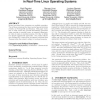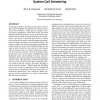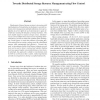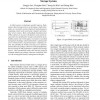101
Voted
SIGOPS
2008
14 years 11 months ago
2008
Power management strategies for embedded systems typically rely on static, application driven deactivation of components (e.g. sleep, suspend), or on dynamic voltage and frequency...
SIGOPS
2008
15 years 21 hour ago
2008
Several real-time Linux extensions are available nowadays. Two of those extensions that have received special attention recently are Preempt-RT and Xenomai. This paper evaluates t...
112
Voted
SIGOPS
2008
15 years 21 hour ago
2008
A principal challenge in operating system design is controlling system throughput and responsiveness while maximizing resource utilization. Unlike previous attempts in kernel reso...
109
click to vote
SIGOPS
2008
15 years 14 days ago
2008
Deployment of shared storage systems is increasing with rapid adoption of virtualization technologies to provide isolation, better management and high utilization of resources. Qu...
122
click to vote
SIGOPS
2008
15 years 14 days ago
2008
The Linux Kernel currently supports at least 8 distinct virtualization systems: Xen, KVM, VMware's VMI, IBM's System p, IBM's System z, User Mode Linux, lguest and ...
93
Voted
SIGOPS
2008
15 years 14 days ago
2008
CUBIC is a congestion control protocol for TCP (transmission control protocol) and the current default TCP algorithm in Linux. The protocol modifies the linear window growth funct...
SIGOPS
2008
15 years 14 days ago
2008
103
click to vote
SIGOPS
2008
15 years 14 days ago
2008
This paper presents PipesFS, an I/O architecture for Linux 2.6 that increases I/O throughput and adds support for heterogeneous parallel processors by (1) collapsing many I/O inte...
SIGOPS
2008
15 years 14 days ago
2008
The layered design of the Linux operating system hides the liveness of file system data from the underlying block layers. This lack of liveness information prevents the storage sy...
116
Voted
SIGOPS
2008
15 years 14 days ago
2008
As flash memory technologies quickly improve, flashmemory-based storage devices are becoming a viable alternative as a secondary storage solution for general-purpose computing sys...





